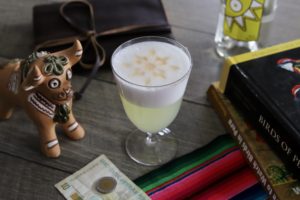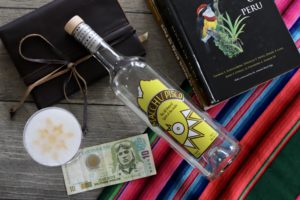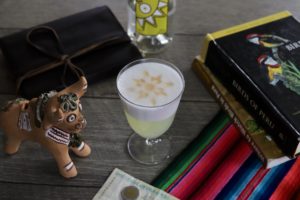 The Pisco Sour will always have a very special place in my heart. I’ve spent a fair bit of time in Peru, both as a tourist and doing ornithology fieldwork, and I’ve drunk my share of the country’s national cocktail. Making it at home always takes me back there in spirit.
The Pisco Sour will always have a very special place in my heart. I’ve spent a fair bit of time in Peru, both as a tourist and doing ornithology fieldwork, and I’ve drunk my share of the country’s national cocktail. Making it at home always takes me back there in spirit.
And speaking of spirits, before we get to the Pisco Sour, let’s talk about Pisco itself. Pisco is essentially an unaged grape brandy, made by distilling fermented grape juice. There are eight different grape varieties that can be used, with Quebranta being the most common. Pisco is meant to represent the pure qualities of the grape. Aging in wood of any kind is prohibited, though the spirit must rest for at least three months in a nonreactive container (such as one made of glass, ceramic, stainless steel). The resulting spirit is bright and clean, with fruity notes like peach and apple in addition to the prominent grape.
Pisco was developed in the sixteenth or seventeenth century, when Spanish settlers brought grape vines from the Canary Islands to South America to produce wine and spirits. The word “pisco” means “bird” in the Quechua language, but it’s unclear how this term became applied to the spirit. It may have gotten its name from the town of Pisco on the Peruvian coast. While not the only producer of the spirit, Pisco may have been a main port for shipping it back to Spain. The Spanish would have called the spirit “Aguardiente de Pisco,” which may have eventually been shortened to “Pisco.” Another possibility is that the Spaniards began calling the spirit after the name of the uniquely-shaped containers it was commonly stored in, “piskos.”

If you start reading about the history of Pisco, you’ll quickly find evidence of the ongoing debate between Peru and Chile as to where exactly the spirit originated. While this is an issue of great importance and national pride to many Peruvians and Chileans, it’s important to remember that the modern border between the two countries did not exist at the time. The Incan Empire, and subsequently the Spanish Empire, extended across the region. Culturally, they can certainly share the claim.
As for which Pisco to buy for your bar, I recommend Macchu Pisco, which is readily available in the US and probably the brand you’re most likely to see on the backbar of your favorite cocktail spot. It’s also a woman-owned company started by two Peruvian sisters, so it’s one you can feel good about supporting. I’ve listed some other options below as well.
Pisco
Price: $25-30
ABV: 40%
Popular Brands: Macchu Pisco, La Caraveda, Pisco Portón
Popular Cocktails: Pisco Sour, Algarrobina, Pisco Punch, Chilcano, Cupid’s Cup
In his 1951 book The South American Gentleman’s Companion, the inimitable Charles H. Baker, Jr. writes of Pisco, “Taken neat it isn’t impressive at all; but in a proper Pisco Sour, we say to you Señoras y Señores: here is a royal caballo of another color.” I daresay he’s right. It’s hard to think of Pisco without immediately connecting it with its signature cocktail. Considered the national drink of both Peru and Chile, this aptly-named recipe is made with Pisco, lime juice, simple syrup, egg white, and bitters. It’s fresh and tart, given a smooth texture and beautiful presentation by the egg white foam on top. This was the first drink I ever had that contained egg whites, and it’s hard not to be won over on the concept when sipping one of these.

In Peru, the Pisco Sour is usually made with key limes, small round fruit that are milder and less acidic than traditional limes. To try to mimic their flavor a little better, I opt for a 50/50 mix of lime and lemon juice in my Pisco Sour, but do grab a bag of key limes if you happen to see them at your grocery store. Another ingredient that will make your Pisco Sour even more authentic is Amargo Chuncho bitters. These are made in Peru from local botanicals, and are the bitters I always saw used for Pisco Sours. Angostura bitters are a fine substitute. On the Pisco Sour in these pictures, I used a spray bottle and stencil to make a more elaborate garnish, but in Peru they’re simply dropped on top, perhaps with the end of a cocktail pick dragged through them to create tiny leaflike designs.
History: As usual, we don’t know for certain who invented the Pisco Sour. I was quite surprised to discover that it’s most commonly attributed to an American from Salt Lake City, Victor Morris. He traveled to Peru in 1903 to work for a railway company. In 1916, he opened a bar in Lima at Calle Boza 847. It became a popular destination, and was known for its Pisco Sour. However, there’s no real evidence that Morris invented the drink, and cocktail historians have dredged up a couple of earlier mentions of “Pisco Sours,” though their recipes are not known. Given that the Sour is a popular cocktail template, and Pisco is a popular spirit in Peru and Chile, it’s very likely that more than one person thought to mix it with citrus and sugar. If Morris didn’t create the beloved version below, with its egg white and bitters, he certainly played a role in immortalizing it.
Pisco Sour
2 oz. Pisco
½ oz lemon juice
½ oz. lime juice
¾ simple syrup
1 egg white
1 dash Amargo de Chuncho bitters (can substitute Angostura)
Combine all ingredients except bitters in a cocktail shaker with ice and shake until chilled. Strain out ice and return the cocktail to the shaker, shaking it for another 30-60 seconds to foam up the egg whites. Strain into a cocktail glass or rocks glass. Drop bitters on top.
Information for this post came from a number of sources, including Wikipedia and the citations therein, Cold Glass, and The Peruvian Times.






I thought maybe I could order a Pisco Sour when we were in Loreto last week. Alas, the liquor control in Mexico limits what the resort could offer. A friend bought Pisco Porton for me a couple years ago and I’ve only attempted to make one ONCE🤷🏼♀️ I think it was good, but I’ll be trying your mix. Loved the article!
Ah, too bad! But if you have a bottle, definitely give it a try at home and let me know how it goes! I was at a restaurant in Boston recently and saw several Pisco Sours leaving the bar, even though it wasn’t on the menu. I suspect you can order one at most places with a decent cocktail program in the States.
Hi Katie, remember me? Just learned that you are not only a serious ornithologist/molecular evolutionist but also an expert in making and garnishing cocktails. Great stuff! 🙂
I will be at a aviculturists’ meeting in two weeks and will present some of your published data on the PNG lonchura species. Are you still doing any work in this field or have you switched completely to blogging and writing? Hope, all is well, stay safe and healthy and best regards from Germany/Switzerland, Sven
Hi Sven, it’s so nice to hear from you! I am no longer working in science. While there are many aspects of it that I love and miss, overall the lifestyle of academia was not for me. I’m so glad that you’ll be making use of our paper and spreading the word about how fascinating the Lonchura system is. Please keep me posted on anything new in the avicultural world related to that group! My advisor Mike Sorenson is hopefully going to continue working on the system and would surely be interested in any crosses between the species, etc. As would I! I’ll give you my email for this blog since it’s already public on here: garnishgirl@garnishblog.com. All the best!